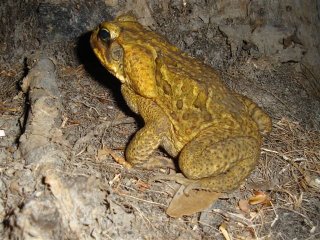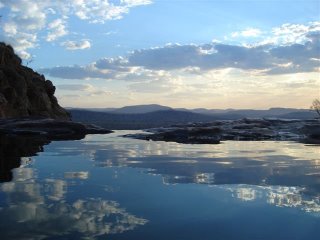From the East Alligator region we moved into Jabiru, the town in which we started life in the Northern Territory. First port of call was a very necessary taste bud stop at the bakery to buy a couple of carrot cake loaves (they taste as good as we remember and have been a daily treat all week). Then a quick windscreen survey of the town followed before settling into the caravan park. We noticed that most of the big African Mahogany trees (albeit exotics) that were so much part and parcel of the place have been reduced to piles of wood chips due to Cyclone Monica. Generally, the trees were considered a problem in Jabiru as the fruit bats would roost in them causing noise and mess and, in the school grounds they were regarded as a risk, tragically proving correct recently, when a 9-year old Darwin schoolboy died after a branch fell on him in the playground. Happily, flocks of white corellas still abounded, causing us to stop and watch one flock’s antics under a sprinkler on the banks of the rugby field, rolling onto their backs and clowning around.
Relief from the heat may have come from having a powered site close to the lagoon-like pool. However, as the day progressed we found ourselves hemmed in by new arrivals and noise from the pool rose steadily. We looked at each other wordlessly thinking we could hardly compare this regimented situation with the informality of our last few nights. We needed to move! Before we could leave Lea was keen to make arrangements to see the few remaining staff along with her former students at Jabiru Area School. Looking at the clock, the school day had ended and we dashed off in hopes of catching the only teacher left from Lea’s time. She struck lucky! Not only was Fay there, she had most of Lea’s old pupils in her class this year. A time was set for 13:20 the next day.
Tuesdays bring the “veggie-man” in his refrigerated truck to town. When we found him down at Lake Jabiru it was like old times purchasing some fresh fruit. Parking on a vacant stand near the lake we immediately set about making ourselves a fruit salad lunch. Time came for Lea to go to the school while George re-visited the Gadudju Crocodile Hotel. This hotel is a remarkable crocodile shaped two-storey building where guests enter through the jaws, sleep and dine in the belly! The circular car parks outside represent the crocodile’s eggs; the ventilation units are housed in its eyes; the pool and barbeque area represent the heart; the walkway the spine and the winding stream that emerges from the pool is the animal’s alimentary canal! It is a rather bizarre design, but eye-catching and refreshingly different.

Gadudju Crocodile Hotel
Four hours later Lea climbed back into Skiv, bending George’s ear with an account of her afternoon as we left Jabiru. Three & four year olds memories of a teacher who is with them for a year, disappears from sight and returns six years later can hardly be expected to remember Mrs Begg… Yet for Lea, it was heart warming to see how they had developed and of course, grown. In sharing her stories of them as tiny preschoolers, Lea’s mere accent seemed to pull threads from the past and a child would suddenly share a recollection of its own. As a bonus, The Darwin Youth Orchestra had been there to perform for the whole school giving Lea the chance to see everyone.
In error, we pulled into the Malabanjbanjdju campsite reserved for tent camping. Its attractive wooded surrounds and nearby billabong, the lack of any tents and the welcoming noisy flock of corellas decided us to stay. Before long both Skiv and Getaway were being covered by a steady rain of leaves being stripped by the corellas in the trees above us, some moaning others squawking like chickens that have just laid an egg. This seemingly destructive behaviour of cockatoos is yet to be explained. Once the sun has set, we were prepared to venture out and do a quick exploration of our vicinity. We crossed over the creek below the billabong and discovered the caravan camping area.
It was set in a thicket of large paper-bark trees; different, yet equally as attractive as our tent camp and a good choice for our next night.
Walking back in the gloaming we encountered two cane toads on the path and their presence gave us pause to think about the latest theory we had read in the paper concerning their impact. Should the goannas, as major predators of crocodile eggs, be depleted by eating poisonous cane toads there will be explosion in the crocodile population. Just one of the possible “swings and roundabouts” that can occur in nature.

The dreaded Cane Toad
The Nourlangie area has always been one of our favourite spots in Kakadu and we looked forward to spending a full day around there. The big outlier, often erroneously referred to by balanda (white people) as Nourlangie Rock, is actually Burrunggui. The word Nawurlandja (anglicised to Nourlangie) refers to the whole area. This huge rock formation contains overhangs and shallow caves, known as galleries, which are rich in Aboriginal art of deep spiritual and cultural significance. Of these Namarrgon (Lightning Man) and Nabulwinjbulwinj (the spirit that eats women) are the most famous. Higher up is the Gunwardewarde Lookout where one may gaze out on the woodlands that extend across the plains of Kakadu, to the escarpment of the Arnhem Land Plateau. There, the distinctive pillar-like sandstone blocks where, reputedly, Lightning Man resided in the Dreaming. We took the more circuitous and natural route winding through the outcrop rather than the paved, more direct way taken by the majority of tour groups.

Burrunggui - “Nourlangie Rock”
Getting on for midday we found a shady spot for Skiv and Getaway alongside the Anbangbang billabong. The noise and activities of the bird life (ducks, geese, jacanas, Jabiru storks, cormorants, corellas and black cockatoos) prompted us to walk the periphery of the wetland, the margins heavily disturbed by feral pigs compelling the Parks to set traps at either end. Magpie geese present on the billabong reminded George of an interesting account he had read about the hunting strategies employed by dingoes. They begin agitating and spooking the birds by repeatedly walking round and around the geese. This so distracts the geese they forget to keep an eye out for avian predators above them. Should a sea-eagle swoop down to take a goose out, the dingo makes the mad dash to steal the eagle’s goose as it rises with its hefty prey. In the shade and comfort of the caravan we were glad to spend the rest of the day alongside the billabong, reading and writing.
As the sun began dropping in the west we climbed the steep rocky expanse of the Nawurlandja lookout, a smaller outlier overlooking Anbangbang, and watched the Arnhem Land escarpment in the east steadily becoming illuminated and the softening light spreading across the plains. Returning in the dark to the caravan site at Malabanjbanjdju we heard what sounded like a couple of two-stroke motor bike engines being tuned up. The cane toads were announcing their presence. We had this strange droning until all “engines” were abruptly turned off around midnight! The silence was almost deafening amongst the paper bark trees.
The Yellow Waters wetlands are a major draw-card for tourists with its boat cruises operating all year round and boardwalk into the swamp. This actually disappears under water in the “Wet” as does the car park – an amazing event that is hard to imagine in the “Dry”. We strolled out along the boardwalk and George was appalled to see a herd of cattle! After all the concerns expressed about feral water buffalo damaging wetlands in Kakadu we could hardly believe we were seeing these well fed bovines in the middle of a World Heritage Site.
When it came time to escape the worst of the heat we slipped into the Warradjan Aboriginal Cultural Centre. The building is designed in the shape of a pig-nosed turtle (warradjan) and is an outstanding display by the traditional owners of Kakadu. At the end of our visit Lea noticed a list of videos that can be shown on request. We were delighted to see Last of Nomads was available. We had been dying to see this film having so enjoyed the book. No better time than now in an air-conditioned room! Disappointingly, after many stops and starts thanks to a faulty sound system, we ended up watching the film without sound.
We had a pleasant night at Mardugal camp with a short sweet dingo chorus to fall asleep to and pushed on to Gunlom the next day. We felt a measure of concern to have 40km of corrugated dirt road ahead of us but decided we could not let past mishaps discourage us. Much of this region is known as “sickness country” by the Aboriginals and quite wisely so because it is a location of potentially harmful minerals, especially uranium. As we drove we began thinking of the jumbled mixture of seasons “Down Under”. Some trees winter bare. Others with the fresh flush of spring leaves and some in autumnal disarray. More, among blackened woodlands with stumps still smouldering, looking decidedly wilted but summery. As we set up camp blustery “willy-willys” hurling dust and leaves in all directions confused us into wondering whether it was winter, summer or autumn.
Featured in the film Crocodile Dundee, the main attraction at Gunlom is the large plunge pool below an 80m high waterfall. However, for us it is undertaking the steep climb to the top of the falls and there being able to cool off from the strenuous effort in a magnificent pool between water worn rocks that have a marbleised sheen to them. Floating in the clear water on the very lip of the falls with a view second to none of southern Kakadu is a truly heady experience. We shared this with no-one and at sunset the cloud reflections across the water were superb.

The lip of the falls taken from within the top pool, Gunlom
That night, while collecting camp fees, the ranger told us that four years ago Gunlom had been the cane toad’s first point of entry into the Park and in the last two years or more he has not seen a single goanna, olive python, king brown snake or quoll.
A wonderful week in Kakadu soon came to an end as we exited the Park’s southern boundary on Saturday making our way through very Rhodesian-like countryside before ending up at the Springvale Homestead not far from Katherine. Springvale, dating back to 1878, is the oldest original station homestead in the NT. A 20 month long epic drove bringing the first livestock of 12 000 sheep and 3 000 cattle to the station from Adelaide all adds to the sense of history here. We have been happy wallowing in the swimming pool alongside a picturesque billabong with some very odd looking guinea-fowl calling continually like old rusty gates and wallabies all roaming around.
No comments:
Post a Comment